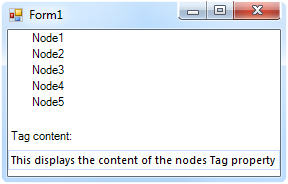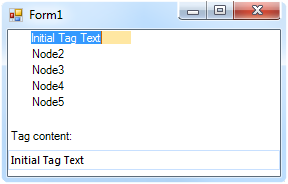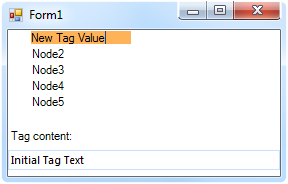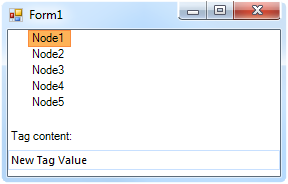Implementing custom editor for RadTreeNode
| Product Version | Product | Author | Last modified |
|---|---|---|---|
| Q2 2010 SP2 | RadTreeView for WinForms | Stefan Stefanov | Sep 22, 2010 |
PROBLEM
This article will demonstrate how to take advantage of a custom editor. In this case using such an editor you will allow you to change the data contained in the RadTreeNode.Tag.

Text = "Node1" Tag = "Initial Tag Text"

Editing the node i.e. the tag property

Setting "New Tag Value" as Tag value
 Text is back to "Node 1", Tag = "New Tag Value"
Text is back to "Node 1", Tag = "New Tag Value"
SOLUTION
You can create a custom TextBox editor by inheriting from RadTextBoxItem and implementing the IValueEditor interface. The following sample implementation demonstrates how to create an editor and replace the default editor for RadTreeNode. This editor behavior is as follows:
Initially the nodes' Text is the default text ("Node 1", "Node 2" ) or something that was explicitly set.
When editing a node by hitting F2, the editor displayes the text that is contained in the Tag property of the same node
After entering some data, and submitting it, the original Text value appears as text for the node, and the submitted text is now the new value for the Tag property
1.Creating the editor:
class MyEditor : RadTextBoxItem, IValueEditor
{
#region IValueEditor Members
string oldValue;
RadTreeNode owner;
public void BeginEdit()
{
this.Focus();
this.HostedControl.Focus();
}
public bool EndEdit()
{
this.owner.Tag = this.Text;
this.owner.Text = oldText;
this.owner.TreeView.EndEdit(true);
return true;
}
private static readonly object ValueChangedEventKey = new object();
protected virtual void OnValueChanged(EventArgs args)
{
EventHandler handler1 = (EventHandler)base.Events[ValueChangedEventKey];
if (handler1 != null)
{
handler1(this, args);
}
}
protected override void OnKeyDown(KeyEventArgs e)
{
base.OnKeyDown(e);
string oldEditorValue = this.Text;
Keys pressedKey = e.KeyCode;
if (pressedKey == Keys.Return)
{
if (e.Modifiers == Keys.None)
{
e.SuppressKeyPress = true;
e.Handled = true;
this.EndEdit();
return;
}
}
else if (pressedKey == Keys.Escape)
{
e.Handled = true;
this.Value = this.oldValue;
this.EndEdit();
return;
}
}
string oldText = "";
public void Initialize(object owner, object value)
{
this.owner = (RadTreeNode)owner;
oldText = this.owner.Text;
this.Text = this.owner.Tag.ToString();
this.oldValue = this.Text;
}
public bool Validate()
{
return true;
}
public event ValidationErrorEventHandler ValidationError;
public object Value
{
set
{
this.Text = value.ToString();
}
get
{
return this.Text;
}
}
public event EventHandler ValueChanged;
public event ValueChangingEventHandler ValueChanging;
#endregion
}
Imports Telerik.WinControls.UI
Public Class MyEditor
Inherits RadTextBoxItem
Implements IValueEditor
Private oldValue As String
Private owner As RadTreeNode
Public Sub BeginEdit() Implements Telerik.WinControls.UI.IValueEditor.BeginEdit
Me.Focus()
Me.HostedControl.Focus()
End Sub
Public Function EndEdit() As Boolean Implements Telerik.WinControls.UI.IValueEditor.EndEdit
Me.owner.Tag = Me.Text
Me.owner.Text = oldText
Me.owner.TreeView.EndEdit(True)
Return True
End Function
Private Shared ReadOnly ValueChangedEventKey As New Object()
Protected Overridable Sub OnValueChanged(ByVal args As EventArgs)
End Sub
Protected Overrides Sub OnKeyDown(ByVal e As KeyEventArgs)
MyBase.OnKeyDown(e)
Dim oldEditorValue As String = Me.Text
Dim pressedKey As Keys = e.KeyCode
If pressedKey = Keys.[Return] Then
If e.Modifiers = Keys.None Then
e.SuppressKeyPress = True
e.Handled = True
Me.EndEdit()
Return
End If
ElseIf pressedKey = Keys.Escape Then
e.Handled = True
Me.Value = Me.oldValue
Me.EndEdit()
Return
End If
End Sub
Private oldText As String = ""
Public Sub Initialize(ByVal owner As Object, ByVal value As Object) Implements Telerik.WinControls.UI.IValueEditor.Initialize
Me.owner = DirectCast(owner, RadTreeNode)
oldText = Me.owner.Text
Me.Text = Me.owner.Tag.ToString()
Me.oldValue = Me.Text
End Sub
Public Function Validate() As Boolean Implements Telerik.WinControls.UI.IValueEditor.Validate
Return True
End Function
Public Event Validated1(ByVal sender As Object, ByVal e As System.EventArgs) Implements Telerik.WinControls.UI.IValueEditor.Validated
Public Event Validating1(ByVal sender As Object, ByVal e As System.ComponentModel.CancelEventArgs) Implements Telerik.WinControls.UI.IValueEditor.Validating
Public Event ValidationError(ByVal sender As Object, ByVal e As Telerik.WinControls.UI.ValidationErrorEventArgs) Implements Telerik.WinControls.UI.IValueEditor.ValidationError
Public Property Value() As Object Implements Telerik.WinControls.UI.IValueEditor.Value
Get
Return Me.Text
End Get
Set(ByVal value As Object)
Me.Text = value.ToString()
End Set
End Property
Public Event ValueChanged(ByVal sender As Object, ByVal e As System.EventArgs) Implements Telerik.WinControls.UI.IValueEditor.ValueChanged
Public Event ValueChanging(ByVal sender As Object, ByVal e As Telerik.WinControls.UI.ValueChangingEventArgs) Implements Telerik.WinControls.UI.IValueEditor.ValueChanging
End Class
2.Changing the default editor in RadTreeView:
void radTreeView1_EditorRequired(object sender, EditorRequiredEventArgs e)
{
e.EditorType = typeof(MyEditor);
MyEditor editor = new MyEditor();
e.Editor = editor;
}
Private Sub RadTreeView1_EditorRequired(ByVal sender As Object, ByVal e As Telerik.WinControls.UI.EditorRequiredEventArgs) Handles RadTreeView1.EditorRequired
e.EditorType = GetType(MyEditor)
Dim editor As New MyEditor()
e.Editor = editor
End Sub